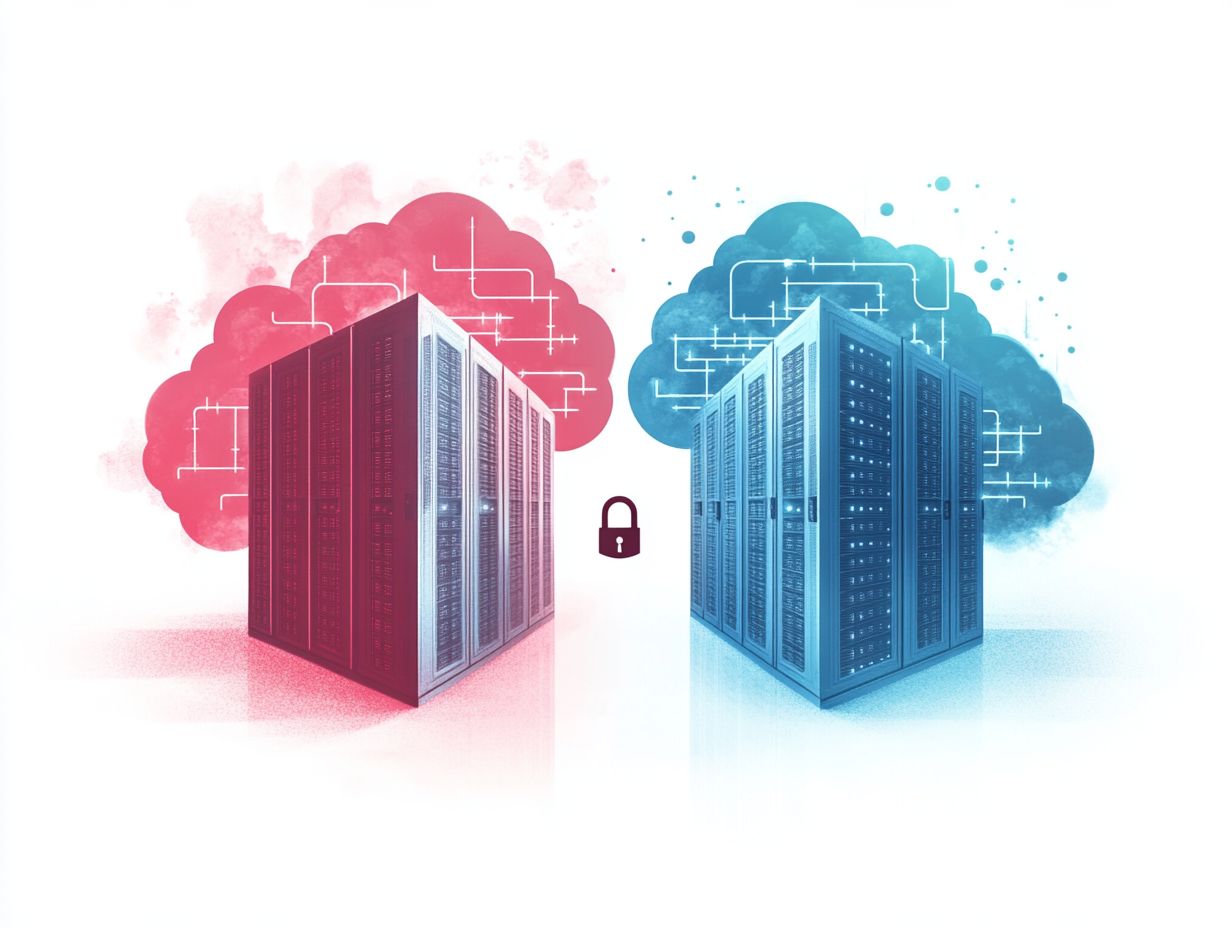Comparing Private vs Public Cloud Providers
Cloud computing has revolutionized business operations. It offers flexibility, scalability, and cost-efficient solutions.
Choosing between private and public cloud models can feel overwhelming. This article simplifies the essentials of cloud computing, showcasing the key differences.
We focus on costs, security, and customization. This empowers you to make informed decisions tailored to your unique business needs.
Jump in now and master the cloud landscape with confidence!
Contents
- Key Takeaways:
- The Basics of Cloud Computing
- Key Differences Between Private and Public Cloud Providers
- Costs and Pricing Models
- Security and Data Privacy
- Customization and Control
- Factors to Consider When Choosing a Cloud Provider
- Business Needs and Goals
- Scalability and Flexibility
- Support and Service Level Agreements
- Frequently Asked Questions
- What is the main difference between private and public cloud providers?
- What are the advantages of using a private cloud provider?
- What are the benefits of using a public cloud provider?
- What factors should be considered when comparing private vs public cloud providers?
- Can a company use both private and public cloud providers?
- Which type of cloud provider is better for my business?
Key Takeaways:

Private clouds offer control and customization but can be more expensive. Public clouds have lower costs and scale easily but may limit security and privacy. Consider your business needs, scalability, and support when choosing between them.
The Basics of Cloud Computing
Cloud computing transforms business operations. It provides flexible, scalable, and efficient solutions.
You can choose from various cloud environments: private, public, or hybrid. Each is designed to meet your unique needs.
Understanding these models is crucial. They optimize your IT management and boost operational flexibility.
Private and Public Clouds Explained
Private clouds provide dedicated environments, enhancing control and security. They are ideal for managing sensitive data.
Public clouds offer scalable resources managed by third-party providers. This helps cut operational costs and optimize resource allocation.
Each cloud model has unique characteristics to meet different needs.
Private clouds, deployed within your organization s firewall, are great for industries with strict regulations, like finance and healthcare. They ensure stringent access controls and oversight of sensitive information.
Public clouds excel in flexibility and rapid scalability. They are ideal for startups or businesses with variable demands.
While public clouds lower costs, they can introduce data privacy challenges. Your data is stored off-site, managed by external providers, which could increase security risks.
Understanding these distinctions helps you select the best cloud solution for your circumstances.
Key Differences Between Private and Public Cloud Providers
Evaluating cloud providers requires understanding the key differences between public and private IaaS. These distinctions influence costs, security protocols, customization, and performance control.
Costs and Pricing Models

Understanding cloud service costs is essential for effective budget management. Options vary from pay-as-you-go to subscription models, leading to potential savings.
Exploring various pricing strategies allows you to align cloud usage with financial goals. Private cloud providers typically offer controlled environments with custom pricing, ideal for stable workloads.
Public cloud services operate on a consumption-based model, providing flexibility but sometimes leading to unpredictable costs.
Weigh these factors carefully. Consider operational overhead, potential vendor lock-in, and how pricing models will influence your cloud adoption strategy.
Security and Data Privacy
Security and data privacy stand as your paramount concerns in cloud computing. You must navigate many security risks while ensuring compliance with industry-specific regulations and standards to protect sensitive customer data.
In both private and public cloud environments, effective security measures are essential for safeguarding information and fostering trust with clients and stakeholders. By implementing robust cybersecurity practices, you can identify potential vulnerabilities and significantly reduce the risk of breaches.
Regulatory compliance plays a critical role in shaping your cloud strategies and data management. Adhering to frameworks like GDPR (General Data Protection Regulation) and HIPAA (Health Insurance Portability and Accountability Act) can have a substantial impact on your operations.
You might find yourself increasingly adopting multi-layered security approaches, encompassing everything from encryption to continuous monitoring, all designed to enhance your overall security posture and mitigate potential risks.
Comprehensive strategies ensure your operations run smoothly in a digital world.
Customization and Control
Customization and control are key aspects that set private clouds apart from public clouds. With private clouds, you gain enhanced configuration options that can be fully customized to meet your specific organizational needs. In contrast, public clouds typically offer a more rigid structure, though they shine in terms of scalability.
When you opt for a private cloud, you’re able to tailor your environment. This flexibility allows for optimized resource allocation and custom security measures, which are essential for meeting regulatory requirements. This customization gives IT managers better control over cloud operations, enabling them to make adjustments that align with evolving business objectives.
On the flip side, public clouds excel in scalability. They make it easy for businesses like yours to ramp up resources during peak times or scale down when things slow down. However, this advantage often comes at the cost of limited customization.
Therefore, carefully evaluate the benefits of tailored solutions against the operational flexibility public resources provide, as this will ultimately shape your cloud strategy.
Factors to Consider When Choosing a Cloud Provider
Make sure you consider key factors when choosing the right cloud provider! Begin by assessing your business needs and goals, ensuring the provider’s offerings align with your strategic vision.
Pay close attention to scalability features and the level of support available. Review the service level agreements to guarantee they meet your organizational priorities and facilitate effective management of your IT resources.
This careful deliberation will ultimately enable you to make a decision that drives your business forward.
Business Needs and Goals

Understanding your organization s unique business needs and goals is essential when selecting a cloud provider that aligns with your overall cloud strategy and effectively supports your business priorities.
These factors not only influence your choice of technology but also play a significant role in cost management, scalability, and the security features vital for long-term success.
For example, if you re a startup concentrating on rapid development, you might prioritize flexibility and cost-effectiveness, leading you to consider providers with pay-as-you-go models. Conversely, if you re part of a large enterprise with a strong focus on robust data security, you ll likely lean towards providers that offer comprehensive compliance solutions.
By clearly defining your objectives and requirements, you can pinpoint cloud vendors that deliver tailored solutions, ensuring the perfect fit for your specific operational environment.
Scalability and Flexibility
Scalability and flexibility are critical factors to consider when adopting cloud solutions. They directly influence your ability to adjust resources in response to shifting workloads and business demands. This ensures a smooth cloud migration and facilitates moving tasks easily.
These attributes help you manage fluctuations in user traffic and application performance. This means you can wow your customers every time without unnecessary delays or interruptions.
By leveraging scalable cloud services, you can seamlessly expand your operations during peak times and scale back during quieter periods. This optimizes costs and enhances your resource allocation.
The inherent flexibility of cloud environments supports various migration strategies, enabling you to choose the approach that aligns best with your objectives. Ultimately, this adaptability boosts your operational efficiency and fosters innovation, allowing you to swiftly test new features or services and sharpen your competitive edge in a dynamic market.
Support and Service Level Agreements
Robust support and well-defined service level agreements (SLAs) are essential when selecting a cloud provider. These elements set clear expectations for performance and uptime, ensuring smooth cloud operations and IT management.
They play a crucial role in maintaining operational efficiency and elevating customer satisfaction within your organization s cloud strategy. By outlining specific metrics for service delivery, SLAs create a framework for monitoring compliance effortlessly and addressing issues before they escalate.
A strong support system tackles technical challenges swiftly while building trust between you and your provider. When you align your cloud services with articulate SLAs and responsive support channels, you can effectively minimize downtime, maximize productivity, and ensure a seamless user experience paving the way for long-term success.
Frequently Asked Questions
What is the main difference between private and public cloud providers?

The main difference between private and public cloud providers is the ownership and access of the cloud infrastructure. Private cloud providers offer dedicated and secure resources owned by a single organization, while public cloud providers offer shared resources accessible to multiple organizations. For a deeper understanding, check out the key takeaways from cloud provider comparisons.
What are the advantages of using a private cloud provider?
Some advantages include increased security and control over data, improved customization and flexibility, and the ability to meet specific regulatory or compliance requirements.
What are the benefits of using a public cloud provider?
Using a public cloud provider can offer benefits like lower costs, scalability, and easier access to a variety of resources and applications. Public clouds also often have a larger global reach and higher availability compared to private clouds.
What factors should be considered when comparing private vs public cloud providers?
Important factors to consider include data security needs, budget constraints, regulatory compliance requirements, and the level of control and customization needed for your organization.
Can a company use both private and public cloud providers?
Yes, a company can use both private and public cloud providers, known as a hybrid cloud model. This allows organizations to take advantage of the benefits of both types of clouds while addressing specific needs and concerns related to their data and applications.
Which type of cloud provider is better for my business?
The best type of cloud provider for your business will depend on your specific needs and priorities. Consider factors like data security, budget, and scalability when deciding between private and public cloud providers, and consult resources like evaluating hybrid cloud options for a comprehensive comparison.
For more information on cloud solutions and how they can benefit your organization, feel free to explore further!





